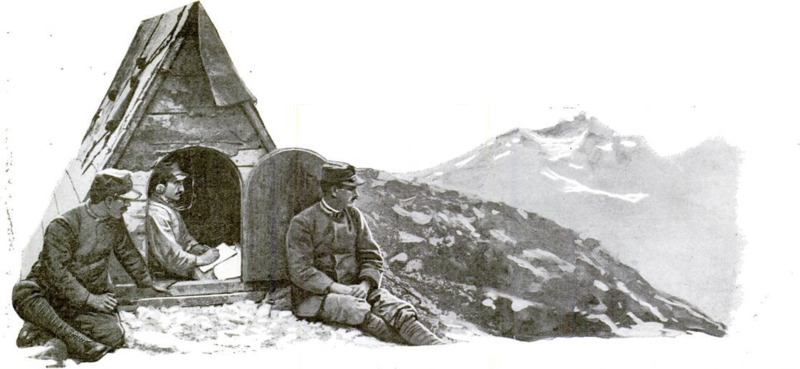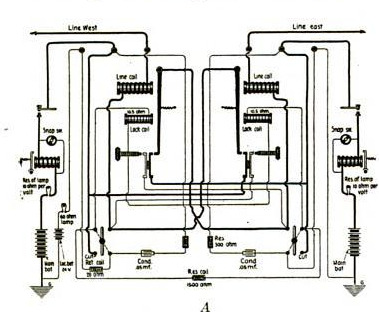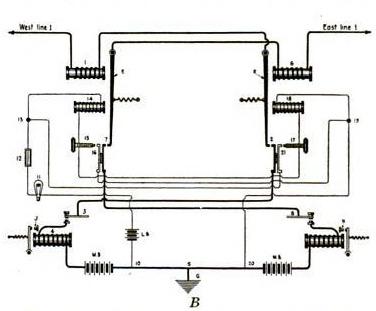-
Title (Dublin Core)
-
The important role played by the American telegraph in the Western front during World War I
-
Article Title and/or Image Caption (Dublin Core)
-
Title: The American Telegraph in France
-
Subtitle: It did its part in overthrowing Berlin
-
extracted text (Extract Text)
-
HAD the great war lasted one more
year or even a few months
longer than it did, America would have
had completed and in operation a
system of modern land-line telegraphs
‘throughout the length and breadth of
France not held by the Teutonic
forces. This had to be done. The
French government telegraphs, of the
open-circuit variety, still universally
employ the antique tape-recording ma-
chines such as we threw into the rub-
bish heap in the first days of the Civil
War; “bluestone” and sal ammoniac
cells have not yet been supplanted by
the dynamo, nor does the typewriter
figure in the game of the wires.
The slowness, sluggishness, and in-
efficiency of the system during hos-
tilities was astounding. The British
government railed and fumed and
fussed about it. One high official even
went so far as to complain publicly, and
in the course of his remarks expressed
no surprise that the “Big Berthas"
still thundered at the trembling gates
of Paris as they had thundered for four
crimson years.
John Bull kicked, M. Poilu shrugged
his shoulders; but the old tape ma-
chines continued to take their time
in negotiating the most vital messages.
Entered then the Yankee. Ho
fussed not; neither did he hesitate or
postpone. His doughboys in khaki
and his gobs in blue laid aside their
shooting-irons, their gas-masks, and
their military dignity, shouldered picks
‘and shovels, strapped on pole-climbers,
grasped_comealongs, puckered their
ipa to the tune of “Dixie,” “Yankee
Doodle,” or “Madelon,” and made the
fur fly along the turnpikes and rail
highways of France from Brittany to
the Hindenburg line, and from the
shores of the English Channel to the
frontiers of Spain.
‘Telegraph construction work is es-
pecially difficult in the western part of
France, due to a rather thin soil in
places, and wolid rock beneath into
which post-holes have to be blasted.
But these boys, disdaining fatigue,
anubbing holidays, scorning those
rocks, carried the work ahead so
rapidly that soon the main arteries
were completed. Dig, sturdy Ameri-
can Morsemen, skimmed from the
cream of the profession in the home-
land, ofled up their typewriters and
their sending arms, American relays
sputtered, American sounder clicked
and clattered, and John Bull ceased
complaining, ‘while M. Poilu let his
Tower jaw fall in blank wonderment.
One of the main faults of the French
telegraphs is the scarcity of apparatus
for automatically repeating from one
line into another. Apparently they
prefer to do this by hand. Their cir-
cuits are necessarily shorter than ours,
0 that long-distance telegrams are ro-
layed by hand a number of times while
en route, and their transmission fs
delayed accordingly.
To defeat those well-nigh fatal
delays, automatic telegraph repeaters
were installed in the more important
base offices by the A.E.F., the type of
apparatus selected for the work being
that now used almost exclusively by
the American Telephone and Tele
graph Company, but which are little
known as yet by the telegraph frater-
nity at large. Diagram A shows the
actual connections, and ‘Diagram B
‘shows the theory as simply and plainly
as possible. It is the latter drawing
that we shall follow in our description.
‘The heavy lines in the diagram indi-
cate the routes of the mainline con-
nections, while the thin lines trace the
‘secondary eireuits.
When at rest there are currents
flowing through both the east and the
‘west lines; their line coils, Nos. 1 and
6, are magnetized, holding their re-
spective relay tongues to a close.
‘Should a distant office on the west
line desire to “send.” his first action is
to open his key. Tnstantly line coil
No. 1, and the local relay coil, No. 4,
demaguetize, allowing their respective
tongues to fal buck.
"Tho east line, entering the apparatus |
through line coil No. 6 and relay
tongue B, becomes. disconnected at.
contact No. 1, when that tongue {alla
back, so that the eas line goes open in
sympathy with the weet. Now, when
the cast line thus opens, the line coil §
becomes demagnatized, und wero i not.
for the litle secondary call, No. 18, the
relay tongue # vould fal back, break:
ing circuit at contact No. 2. Should
this actually occur, both contacts, No.
7 and No. 2, would be open, rendering
it an impossibility for either the east or
the west to restore the lines to a normal
‘close again.
The tongue F must be kept closed
While the west “sends,” so that the
latter may at all times enjoy an un-
broken pathway through contact No. 2.
AB and DC are uprights of spring
steel, each pair being connected by an
insulating medium (indicated by di-
agonal lines in the diagram), so that
they move in unison.
When the contact No. 7 is opened
through the demagnetization of the
coil INo. 1, the springs DC, no longer
held to the left by tongue E, open con-
tact No. 16. At this instant, and
before the tongue F' has had time to
sever connection No. 2, the current
from local battery LB, ascending to
contact No. 13, has had two pathways
to choose. It may either travel la-
boriously through the coil No. 14,
through 15 and 17 to coil 18, magnetize
that coil in turn, and then meander on-
ward through 19, 20, and 5 to the
ground; or it may, and does, take the
far easier road by disdaining coil
No. 14 entirely, parting company at
13, and making for the ground through
the one coil No. 18. The latter coil
now being magnetized, the tongue F is
held to a firm close at contact No. 2,
even though there is no current
flowing through line coil No. 6.
When the western operator closes
his key to carve out his first signal, the
contact No. 2 being unbroken, the
entire apparatus falls back as it was in
the beginning. The western current
‘magnetizes coil No. 1, jumps through
tongue F and contact No. 2, through
key No. 3, magnetizes local relay No. 4,
picks up more battery, and jumps to the
ground from 5. When coil No. 1 is thus
magnetized, tongue E closes contact
No.7, again closing the east line through
key No. 8, local relay No. 9, adds
the battery, and goes to the ground.
Should the east open to send to the
west, the action heretofore described is
simply reversed, the action of the
secondary circuit being as follows:
The local current reaches 13, but is
prevented from jumping to the ground
through coil No. 18, because contact
No. 21 opened when, due to the de-
magnetization of coil No. 6, the tongue
F fell open. The local current then
has no choice other than to continue
onward from 13 into coil No. 14. This
coil it magnetizes, holding tongue E to
a close. As the tongue E is closed, the
spring contact No. 16 is also closed,
affording a pathway for the local cur-
rent after it leaves the coil No. 14,
through 15, 16, 19, 20, and 5, to the
ground.
In practice there are switches, re-
sistances, condensers, ete., as pictured
in Diagram A, the various uses of
which are obvious.
-
Contributor (Dublin Core)
-
Samuel W. Beach (Article writer)
-
Language (Dublin Core)
-
eng
-
Date Issued (Dublin Core)
-
1919-05
-
pages (Bibliographic Ontology)
-
84, 86
-
Rights (Dublin Core)
-
Public domain (Google digitized)
-
Archived by (Dublin Core)
-
Davide Donà
-
Marco Bortolami (editor)
 Popular Science Monthly, v. 94, n. 5, 1919
Popular Science Monthly, v. 94, n. 5, 1919






